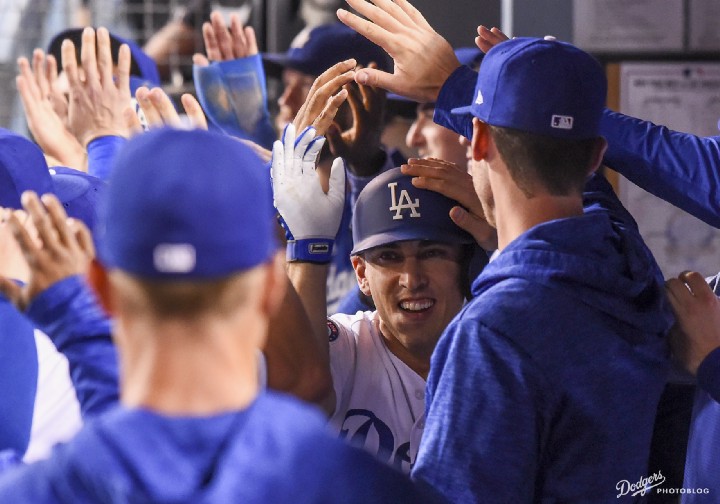
In 2018, Austin Barnes had a .409 OBP through May 21, but .278 thereafter.
(Juan Ocampo/Los Angeles Dodgers)
All along, 2019 was supposed to be the season of Austin Barnes. The year that Yasmani Grandal would leave the Dodgers as a free agent was perfectly timed for Barnes to complete his journey from the minors to the major-league bench and finally the starting lineup of a title contender.
If anything, Barnes seemed to accelerate that timetable in 2017, when he parlayed a .408 regular-season on-base percentage and a Grandal slump into 13 postseason starts, including all seven games of the World Series. He began the playoffs by reaching base seven times in his first 13 trips, including a home run off Zack Greinke, and in the ninth inning of the wild World Series Game 5, Barnes doubled and then scored the Dodgers’ 12th run to tie the game.
Barnes’ overall ’17 World Series numbers were meager, but it seemed clear that at 28, he was ready for the big time, with a disciplined bat and advanced defensive skills that even allowed him to moonlight at second and third base.
The 2018 season actually began better than you probably remember. Through his first 40 games, Barnes’ on-base percentage was a robust .409, almost precisely tracking his previous campaign.
But what power Barnes had previously shown disappeared — four extra-base hits in his first 71 at-bats — and then just before Memorial Day, things went completely downhill. From May 21 through the end of August, Barnes’ OBP was a declining .280, and his slugging percentage an imperceptible .202 (two doubles, no homers in 104 at-bats).
Barnes showed small signs of life in September, hitting three homers to cover for continued OBP struggles. In the postseason, Grandal’s nationally televised dance with offensive and defensive oblivion kept Barnes in semi-regular duty, but he was no antidote: 32 plate appearances, three singles, three walks and 14 strikeouts.
Barnes wasn’t unlucky in 2018, with a .287 batting average on balls in play standing in sharp contrast to his .205 batting average. And his mastery of the strike zone deteriorated. His ratio of strikeouts to walks in 2017 was almost exactly 1:1. In 2018, it became more than 2:1.
Now 29 and coming off his worst professional season, Barnes stands at the precipice of relevance, with two-term Dodger Russell Martin attempting his own comeback from the abyss and prospects Will Smith and Keibert Ruiz preparing to challenge over the next year or two. It’s no accident that the top offseason acquisition target for many Dodger fans was not outfielder Bryce Harper, but rather catcher J.T. Realmuto.
But catchers can be late bloomers, especially those who have a sense of where the wild pitchers are. Until nine months ago, there was little reason to think Barnes wouldn’t be a starting catcher in 2019. The question now is whether there’s any reason to think he could be.
Have pitchers found weaknesses in Barnes he can’t counter? Or is there an adjustment he can make that would revitalize him? Given that his .400-plus OBP days aren’t even a year in the past, people are probably counting him out too quickly — but he also doesn’t have a whole lot of time to prove the doubters wrong.




Comments are closed.